
The Cyperaceae are a family of graminoid (grass-like), monocotyledonous flowering plants known as sedges. The family is large, with some 5,500 known species described in about 90 genera, the largest being the "true sedges" genus Carex with over 2,000 species.

Rhynchospora colorata, also known as starrush whitetop, white star sedge and white-topped sedge, is a perennial sedge with white bracts, giving it the appearance of white petals with long, green points. It is native to southeastern North America, from Virginia west to New Mexico in the United States, and south into the Caribbean islands.

Rhynchospora is a genus of about 400 species of sedges with a cosmopolitan distribution. The genus includes both annual and perennial species, mostly with erect 3-sided stems and 3-ranked leaves. The achenes bear a beak-like tubercule and are sometimes subtended by bristles. Many of the species are similar in vegetative appearance, and mature fruits are needed to make a positive identification.

Little Manatee River State Park is a 2,433-acre (985 ha) Florida State Park located 5 miles (8.0 km) south of Sun City, off U.S. Route 301 on Lightfoot Road and along the Little Manatee River. The park was established in 1974 as Little Manatee River State Recreation Area with 663 hectares. It was designated as a state park in March 1999. The Florida Department of Environmental Protection's Division of Recreation and Parks manages that park under a 99-year lease, set to expire April 10, 2074.
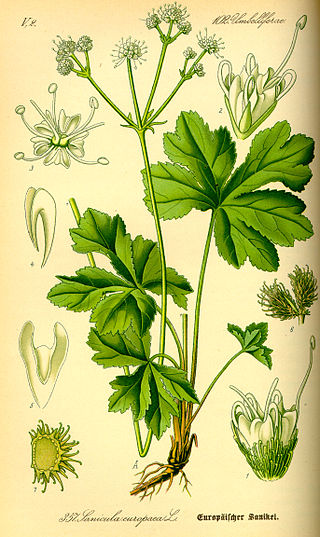
Sanicula is a genus of plants in family Apiaceae, the same family to which the carrot and parsnip belong. This genus has about 45 species worldwide, with at least 22 in North America. The common names usually include the terms sanicle or black snakeroot.

Drosera filiformis, commonly known as the thread-leaved sundew, is a small, insectivorous, rosette-forming species of perennial herb. A species of sundew, it is unusual within its genus in that the long, erect, filiform (thread-like) leaves of this plant unroll in spirals – an arrangement similar to the circinate vernation seen in ferns.

Rhynchospora alba, the white beak-sedge, is a plant in the sedge family, Cyperaceae. It is a tufted herbaceous perennial around 50 cm tall, with white inflorescences that flower in August. The fruit of the sedge is a small achene with a characteristic beak-like cap. It is dispersed by wind or falls by gravity, leading to individuals existing in tight clumps. The species favours wet, acidic and nutrient poor soils, thriving in Sphagnum-dominated bogs, but also peaty grasslands. As such it is often used as a positive indicator for bog and mire ecosystem health.

Tiedemannia canbyi is a rare species of flowering plant in the carrot family known as Canby's dropwort and Canby's cowbane. It is native to the southeastern United States, where it occurs on the Atlantic coastal plain from North Carolina to Georgia, as well as the Chesapeake Bay area. It is threatened by the loss of the wetland habitat in which it grows. It is a federally listed endangered species of the United States.
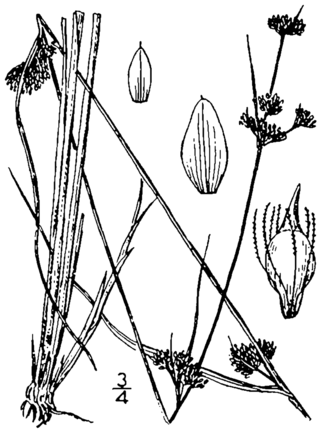
Rhynchospora capillacea is a species of sedge known by the common names needle beaksedge, slender beakrush and needle beakrush. It is native to eastern North America from Labrador to Alberta, and south to Texas. It grows in wet, usually calcareous habitat, such as fens, sandy or stony shores, interdunal flats, and wet meadows It is a perennial herb producing clumps of stems 10 to 40 centimeters tall, each stem with very narrow, filiform leaves. The inflorescence consists of few (1-4) narrow brown spikelets each about 6 or 7 millimeters long.
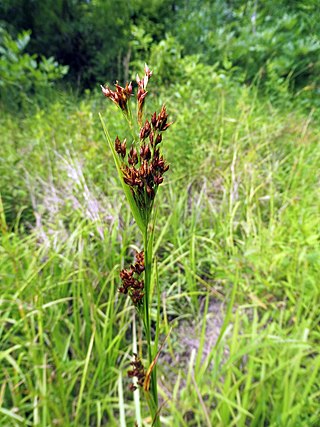
Rhynchospora caduca, commonly called anglestem beaksedge, is a species of flowering plant in the sedge family (Cyperaceae). It is native to North America, where it is found in the southeastern United States. Its typical natural habitat is in low, wet areas, such as in marshes, seeps, tidal swamps, pine savannas, and flatwoods.

Rhynchospora scirpoides, also referred to as Psilocarya scirpoides; common names long-beaked beaksedge and long-beaked bald rush; is a plant in the Rhynchospora genus found in North America.

Rhynchospora corymbosa, known by the common names of golden beaksedge and matamat, is a member of the sedge family, Cyperaceae. It is a perennial herb, found globally throughout the tropics. It grows up to 2 meters tall in riverbanks, shallow pools, and swamps.

Rhynchospora rugosa, known by the common name of claybank beaksedge, is a member of the sedge family, Cyperaceae. It is a perennial herb, native to Central and South America.
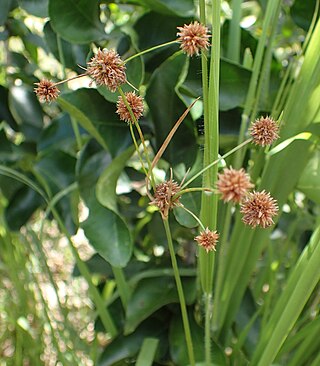
Rhynchospora holoschoenoides, known by the common name of fly beaksedge, is a member of the sedge family, Cyperaceae. It is a perennial herb, found throughout the Caribbean, Central and South America and western and southern Africa.

Rhynchospora riedeliana is a member of the sedge family, Cyperaceae. It is a perennial herb, native to the state of Minas Gerais in Brazil.
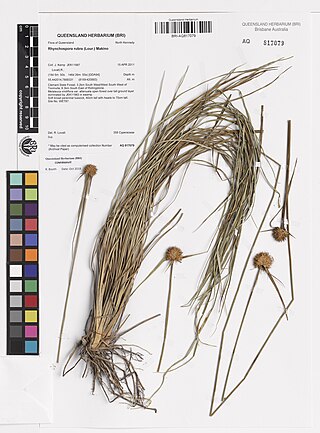
Rhynchospora rubra is a member of the sedge family, Cyperaceae. It found throughout southeast Asia, Oceania, and western and southern Africa.
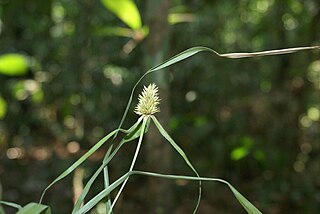
Rhynchospora cephalotes is a member of the sedge family, Cyperaceae. It is a perennial herb, found throughout the tropics of Central and South America, from southern Mexico and western Cuba in the northern extreme to Bahia and Bolivia in the southern extreme.
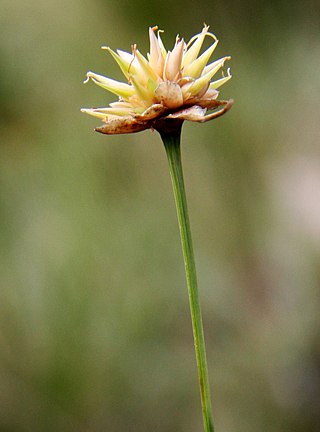
Rhynchospora globosa, known by the Spanish common name of estrellita de sabana, is a member of the sedge family, Cyperaceae. It is a perennial herb, found throughout the tropics of Central and South America. The variant R. globosa var. tenuifolia is endemic to Cuba.
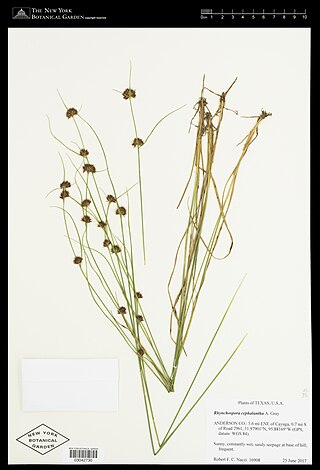
Rhynchospora cephalantha, known by the common name of bunched beaksedge, is a member of the sedge family, Cyperaceae. It is a perennial herb, found throughout the eastern United States, from New York to Texas.



















